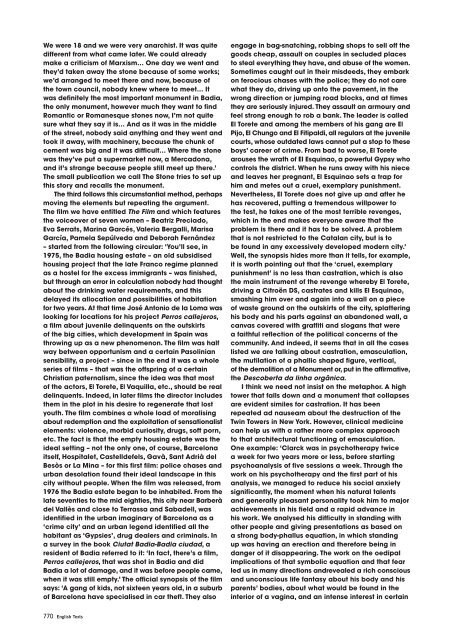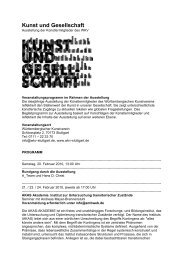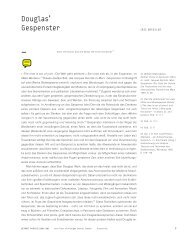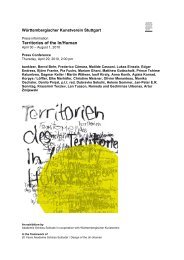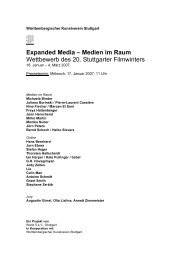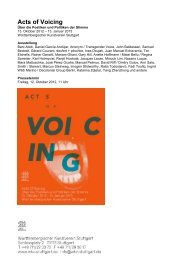English Texts
English Texts
English Texts
Create successful ePaper yourself
Turn your PDF publications into a flip-book with our unique Google optimized e-Paper software.
We were 18 and we were very anarchist. It was quite<br />
different from what came later. We could already<br />
make a criticism of Marxism… One day we went and<br />
they’d taken away the stone because of some works;<br />
we’d arranged to meet there and now, because of<br />
the town council, nobody knew where to meet… It<br />
was definitely the most important monument in Badia,<br />
the only monument, however much they want to find<br />
Romantic or Romanesque stones now, I’m not quite<br />
sure what they say it is… And as it was in the middle<br />
of the street, nobody said anything and they went and<br />
took it away, with machinery, because the chunk of<br />
cement was big and it was difficult… Where the stone<br />
was they’ve put a supermarket now, a Mercadona,<br />
and it’s strange because people still meet up there.’<br />
The small publication we call The Stone tries to set up<br />
this story and recalls the monument.<br />
The third follows this circumstantial method, perhaps<br />
moving the elements but repeating the argument.<br />
The film we have entitled The Film and which features<br />
the voiceover of seven women – Beatriz Preciado,<br />
Eva Serrats, Marina Garcés, Valeria Bergalli, Marisa<br />
García, Pamela Sepúlveda and Deborah Fernández<br />
– started from the following circular: ‘You’ll see, in<br />
1975, the Badia housing estate – an old subsidised<br />
housing project that the late Franco regime planned<br />
as a hostel for the excess immigrants – was finished,<br />
but through an error in calculation nobody had thought<br />
about the drinking water requirements, and this<br />
delayed its allocation and possibilities of habitation<br />
for two years. At that time José Antonio de la Loma was<br />
looking for locations for his project Perros callejeros,<br />
a film about juvenile delinquents on the outskirts<br />
of the big cities, which development in Spain was<br />
throwing up as a new phenomenon. The film was half<br />
way between opportunism and a certain Pasolinian<br />
sensibility, a project – since in the end it was a whole<br />
series of films – that was the offspring of a certain<br />
Christian paternalism, since the idea was that most<br />
of the actors, El Torete, El Vaquilla, etc., should be real<br />
delinquents. Indeed, in later films the director includes<br />
them in the plot in his desire to regenerate that lost<br />
youth. The film combines a whole load of moralising<br />
about redemption and the exploitation of sensationalist<br />
elements: violence, morbid curiosity, drugs, soft porn,<br />
etc. The fact is that the empty housing estate was the<br />
ideal setting – not the only one, of course, Barcelona<br />
itself, Hospitalet, Castelldefels, Gavà, Sant Adrià del<br />
Besòs or La Mina – for this first film: police chases and<br />
urban desolation found their ideal landscape in this<br />
city without people. When the film was released, from<br />
1976 the Badia estate began to be inhabited. From the<br />
late seventies to the mid eighties, this city near Barberà<br />
del Vallès and close to Terrassa and Sabadell, was<br />
identified in the urban imaginary of Barcelona as a<br />
‘crime city’ and an urban legend identified all the<br />
habitant as ‘Gypsies’, drug dealers and criminals. In<br />
a survey in the book Ciutat Badia-Badia ciudad, a<br />
resident of Badia referred to it: ‘In fact, there’s a film,<br />
Perros callejeros, that was shot in Badia and did<br />
Badia a lot of damage, and it was before people came,<br />
when it was still empty.’ The official synopsis of the film<br />
says: ‘A gang of kids, not sixteen years old, in a suburb<br />
of Barcelona have specialised in car theft. They also<br />
engage in bag-snatching, robbing shops to sell off the<br />
goods cheap, assault on couples in secluded places<br />
to steal everything they have, and abuse of the women.<br />
Sometimes caught out in their misdeeds, they embark<br />
on ferocious chases with the police; they do not care<br />
what they do, driving up onto the pavement, in the<br />
wrong direction or jumping road blocks, and at times<br />
they are seriously injured. They assault an armoury and<br />
feel strong enough to rob a bank. The leader is called<br />
El Torete and among the members of his gang are El<br />
Pijo, El Chungo and El Fitipaldi, all regulars at the juvenile<br />
courts, whose outdated laws cannot put a stop to these<br />
boys’ career of crime. From bad to worse, El Torete<br />
arouses the wrath of El Esquinao, a powerful Gypsy who<br />
controls the district. When he runs away with his niece<br />
and leaves her pregnant, El Esquinao sets a trap for<br />
him and metes out a cruel, exemplary punishment.<br />
Nevertheless, El Torete does not give up and after he<br />
has recovered, putting a tremendous willpower to<br />
the test, he takes one of the most terrible revenges,<br />
which in the end makes everyone aware that the<br />
problem is there and it has to be solved. A problem<br />
that is not restricted to the Catalan city, but is to<br />
be found in any excessively developed modern city.’<br />
Well, the synopsis hides more than it tells, for example,<br />
it is worth pointing out that the ‘cruel, exemplary<br />
punishment’ is no less than castration, which is also<br />
the main instrument of the revenge whereby El Torete,<br />
driving a Citroën DS, castrates and kills El Esquinao,<br />
smashing him over and again into a wall on a piece<br />
of waste ground on the outskirts of the city, splattering<br />
his body and his parts against an abandoned wall, a<br />
canvas covered with graffiti and slogans that were<br />
a faithful reflection of the political concerns of the<br />
community. And indeed, it seems that in all the cases<br />
listed we are talking about castration, emasculation,<br />
the mutilation of a phallic shaped figure, vertical,<br />
of the demolition of a Monument or, put in the affirmative,<br />
the Descoberta da linha orgânica.<br />
I think we need not insist on the metaphor. A high<br />
tower that falls down and a monument that collapses<br />
are evident similes for castration. It has been<br />
repeated ad nauseam about the destruction of the<br />
Twin Towers in New York. However, clinical medicine<br />
can help us with a rather more complex approach<br />
to that architectural functioning of emasculation.<br />
One example: ‘Clarck was in psychotherapy twice<br />
a week for two years more or less, before starting<br />
psychoanalysis of five sessions a week. Through the<br />
work on his psychotherapy and the first part of his<br />
analysis, we managed to reduce his social anxiety<br />
significantly, the moment when his natural talents<br />
and generally pleasant personality took him to major<br />
achievements in his field and a rapid advance in<br />
his work. We analysed his difficulty in standing with<br />
other people and giving presentations as based on<br />
a strong body-phallus equation, in which standing<br />
up was having an erection and therefore being in<br />
danger of it disappearing. The work on the oedipal<br />
implications of that symbolic equation and that fear<br />
led us in many directions andrevealed a rich conscious<br />
and unconscious life fantasy about his body and his<br />
parents’ bodies, about what would be found in the<br />
interior of a vagina, and an intense interest in certain<br />
770 <strong>English</strong> <strong>Texts</strong>


